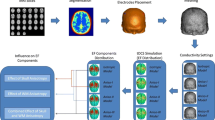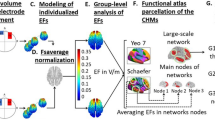Abstract
Transcranial direct current stimulation (tDCS) is a therapeutic and complementary treatment in several cognitive diseases, psychiatric disorders, and disabilities that occur due to an accident or stroke. In the current research, we aimed to boost some parts of the stimulation structure and proposed a new electrode scheme in the mentioned approach. After segmenting magnetic resonance imaging (MRI) scans and using a tissue correction routine algorithm, we attempted to create an appropriate head model and electrode placement according to electric stimulation, whereby we completed tDCS processing. The considered electrodes are divided into two general categories. All the considered electrodes consist of rectangular, circular, triangular, and empty triangular patches with specific dimensions. We investigated common electrode schemes and introduced better electrode schemes for more effective cortical stimulation. We observed that the triangular electrodes in the conventional and anodal arrangement in the triangular 4 × 1 HD-tDCS create more electric field than others. Also, we calculated the current density and attempted to substantially improve it. Therefore, we recommended the empty triangular schemes. We investigated the designed model thoroughly and observed that it increased the current density not only in the conventional but also in the HD-tDCS.

Graphical abstract







Similar content being viewed by others
References
Donnan GA, Fisher M, Macleod M et al (2008) Stroke. Lancet. 371:1612–1623
Brady MC, Kelly H, Godwin J, Enderby P, Campbell P (2016) Speech and language therapy for aphasia following stroke. Cochrane Database Syst Rev (6):CD000425. https://doi.org/10.1002/14651858.CD000425.pub4
Elsner B, Kugler J, Pohl M, Mehrholz J (2019) Transcranial direct current stimulation for improving aphasia after stroke: What’s the current evidence? Stroke 50:e248–e249
Yourganov G, Smith KG, Fridriksson J, Rorden C (2015) Predicting aphasia type from brain damage measured with structural MRI. Cortex 73:203–215
Bhattacharjee S, Kashyap R, Rapp B, Oishi K, Desmond JE, Chen SA (2019) Simulation analyses of tDCS montages for the investigation of dorsal and ventral pathways. Sci Rep 9:1–17
Galletta EE, Cancelli A, Cottone C, Simonelli I, Tecchio F, Bikson M, Marangolo P (2015) Use of computational modeling to inform tDCS electrode montages for the promotion of language recovery in post-stroke aphasia. Brain Stimulation 8:1108–1115
Nitsche MA, Paulus W (2000) Excitability changes induced in the human motor cortex by weak transcranial direct current stimulation. J Physiol 527:633–639
Brunoni A, Nitsche M, Loo C (2016) Transcranial direct current stimulation in neuropsychiatric disorders. Springer, Cham
Bikson M, Rahman A, Datta A (2012) Computational models of transcranial direct current stimulation. Clinical EEG and neuroscience 43:176–183
Lee SY, Cheon H-J, Yoon KJ, Chang WH, Kim Y-H (2013) Effects of dual transcranial direct current stimulation for aphasia in chronic stroke patients. Ann Rehabil Med 37:603
Metwally MK, Han SM, Kim T-S (2015) The effect of tissue anisotropy on the radial and tangential components of the electric field in transcranial direct current stimulation. Med Biol Eng Comput 53:1085–1101
Parazzini M, Fiocchi S, Rossi E, Paglialonga A, Ravazzani P (2011) Transcranial direct current stimulation: estimation of the electric field and of the current density in an anatomical human head model. IEEE Trans Biomed Eng 58:1773–1780
Antal A, Polania R, Schmidt-Samoa C, Dechent P, Paulus W (2011) Transcranial direct current stimulation over the primary motor cortex during fMRI. Neuroimage 55:590–596
Kessler SK, Minhas P, Woods AJ, Rosen A, Gorman C, Bikson M (2013) Dosage considerations for transcranial direct current stimulation in children: a computational modeling study. PLoS One 8:e76112
Im C-H, Jung H-H, Choi J-D, Lee SY, Jung K-Y (2008) Determination of optimal electrode positions for transcranial direct current stimulation (tDCS). Phys Med Biol 53:N219
DaSilva AF, Volz MS, Bikson M, Fregni F (2011) Electrode positioning and montage in transcranial direct current stimulation. J Vis Exp (51):2744. https://doi.org/10.3791/2744
Laakso I, Tanaka S, Mikkonen M, Koyama S, Hirata (2017) A Variability in TDCS electric fields: Effects of electrode size and configuration. In: 2017 XXXIInd General Assembly and Scientific Symposium of the International Union of Radio Science (URSI GASS). IEEE, pp 1–4
Alam M, Truong DQ, Khadka N, Bikson M (2016) Spatial and polarity precision of concentric high-definition transcranial direct current stimulation (HD-tDCS). Phys Med Biol 61:4506
Kuo H-I, Bikson M, Datta A, Minhas P, Paulus W, Kuo M-F, Nitsche MA (2013) Comparing cortical plasticity induced by conventional and high-definition 4× 1 ring tDCS: a neurophysiological study. Brain Stimulation 6:644–648
Cheng DK (1989) Field and wave electromagnetics. Pearson, New Delhi
Maier O, Menze BH, von der Gablentz J, Häni L, Heinrich MP, Liebrand M et al (2017) ISLES 2015 -a public evaluation benchmark for ischemic stroke lesion segmentation from multispectral MRI. Med Image Anal 35:250–269
Huang Y, Dmochowski JP, Su Y, Datta A, Rorden C, Parra LC (2013) Automated MRI segmentation for individualized modeling of current flow in the human head. J Neural Eng 10:066004
Kronberg G, Bikson M (2012) Electrode assembly design for transcranial direct current stimulation: a FEM modeling study. In: 2012 Annual International Conference of the IEEE Engineering in Medicine and Biology Society. IEEE, pp 891–895
Ramaraju S, Roula MA, McCarthy PW (2018) Modelling the effect of electrode displacement on transcranial direct current stimulation (tDCS). J Neural Eng 15:016019
Faria P, Hallett M, Miranda PC (2011) A finite element analysis of the effect of electrode area and inter-electrode distance on the spatial distribution of the current density in tDCS. J Neural Eng 8:066017
Opitz A, Paulus W, Will S, Antunes A, Thielscher A (2015) Determinants of the electric field during transcranial direct current stimulation. Neuroimage 109:140–150
Chen L, Zou X, Tang R, Ke A, He J (2019) Effect of electrode-electrolyte spatial mismatch on transcranial direct current stimulation: a finite element modeling study. J Neural Eng 16:056012
Dmochowski JP, Datta A, Huang Y, Richardson JD, Bikson M, Fridriksson J, Parra LC (2013) Targeted transcranial direct current stimulation for rehabilitation after stroke. Neuroimage 75:12–19
Dougherty ET (2015) Computation and Numerics in Neurostimulation. Virginia Tech. https://vtechworks.lib.vt.edu/handle/10919/73350
Dougherty ET, Turner JC (2016) An object-oriented framework for versatile finite element based simulations of neurostimulation. J Comput Med . https://doi.org/10.1155/2016/9826596
Nasseri P, Nitsche MA, Ekhtiari H (2015) A framework for categorizing electrode montages in transcranial direct current stimulation. Front Hum Neurosci 9:54
Antal A, Alekseichuk I, Bikson M, Brockmöller J, Brunoni AR, Chen R, Cohen L, Dowthwaite G, Ellrich J, Flöel A (2017) Low intensity transcranial electric stimulation: safety, ethical, legal regulatory and application guidelines. Clin Neurophysiol 128:1774–1809
Manoli Z, Parazzini M, Ravazzani P, Samaras T (2017) The electric field distributions in anatomical head models during transcranial direct current stimulation for post-stroke rehabilitation. Med Phys 44:262–271
Acknowledgments
This work was supported by Iran Cognitive Sciences and Technologies Council (Project 4547).
Author information
Authors and Affiliations
Corresponding author
Additional information
Publisher’s note
Springer Nature remains neutral with regard to jurisdictional claims in published maps and institutional affiliations.
Maryam Yousefian is co-first author.
Rights and permissions
About this article
Cite this article
Amani, A., Yousefian, M., Seyedarabi, H. et al. Effect of triangular electrode schemes on Broca’s cortical stimulation: conventional and HD-tDCS study. Med Biol Eng Comput 59, 913–924 (2021). https://doi.org/10.1007/s11517-021-02338-6
Received:
Accepted:
Published:
Issue Date:
DOI: https://doi.org/10.1007/s11517-021-02338-6




